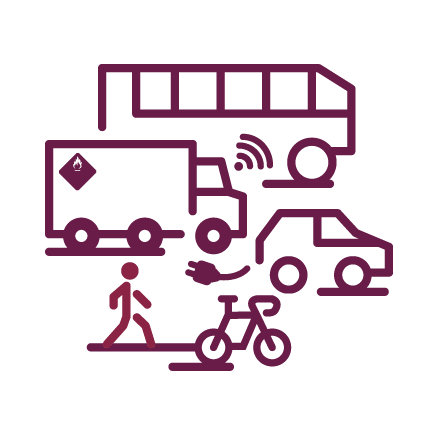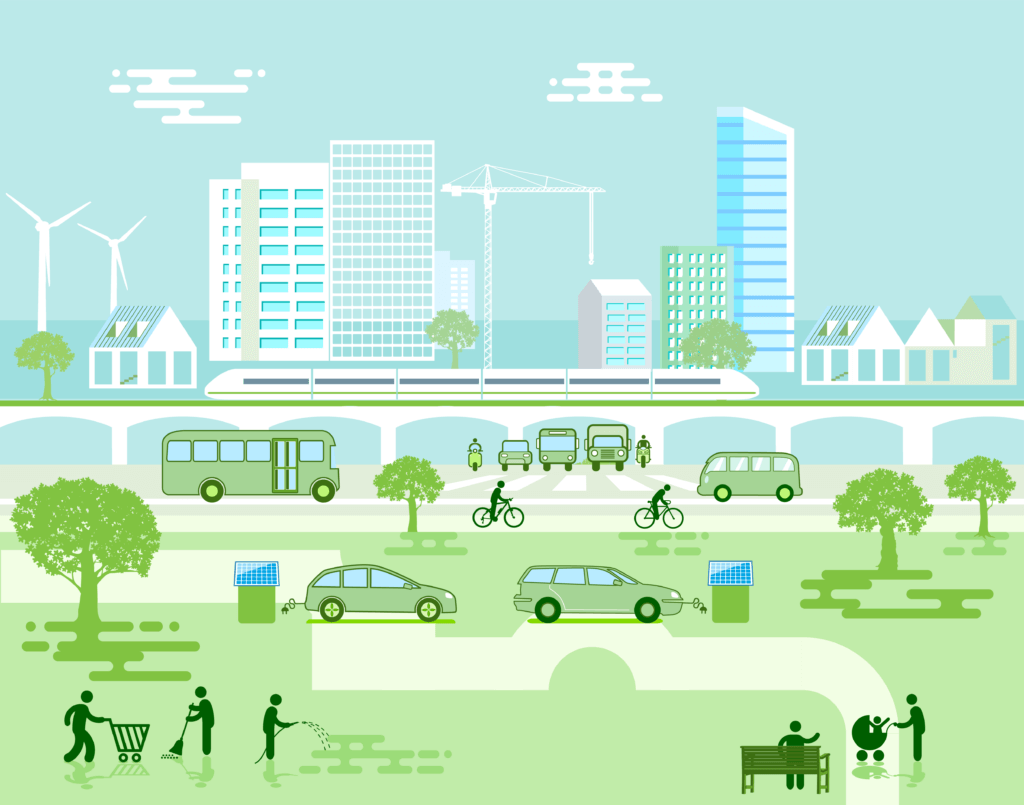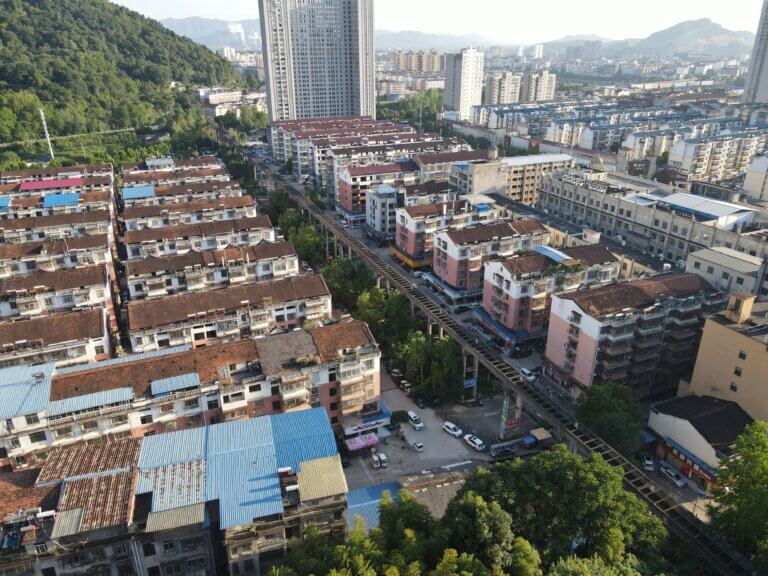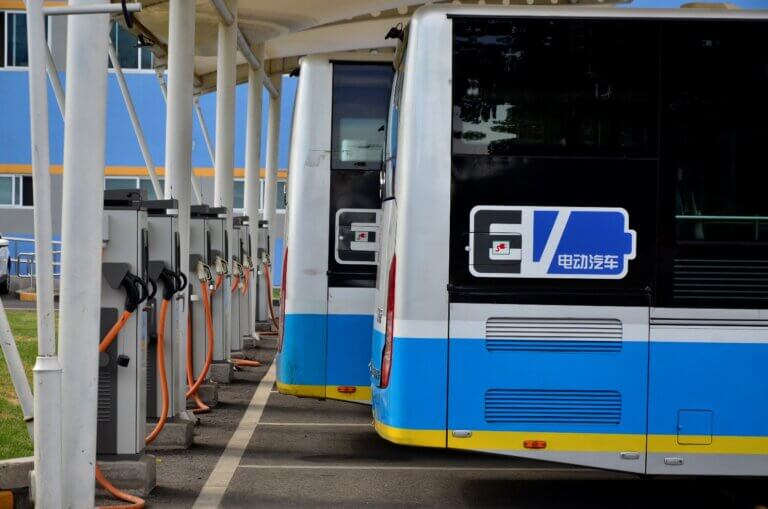China on 28 October 2021, officially submitted its updated Nationally Determined Contributions (NDCs) to the United Nations Framework Convention on Climate Change (UNFCCC). In the core of China’s NDC update stand the targets to achieving CO2 emission peaking before 2030 and carbon neutrality before 2060. With the “Working guidance for carbon dioxide peaking and carbon neutrality in full and faithful implementation of the new development philosophy”, which, as part of China’s “1+N policy system for CO2 peaking and carbon neutrality” (see Figure 1) was issued on 24 October 2021, China’s course towards zero emissions is set – and transport plays a key role in achieving the 2030 and 2060 climate targets.

China’s transport sector accounts for approximately 11% of total energy-related CO2 emissions. With further growing passenger and freight transport volumes, emissions both carbon and air pollutant emissions are expected to further grow. To significantly lower transport sector emissions, in particular the integration of the energy and transport transition as well as the low carbon transformation of the road freight, maritime and aviation transport sectors are of high importance – both in terms of the development of effective strategies and policies and the implementation of concrete measures.
To address the growing challenges, a holistic approach is required to develop innovative solutions that can effectively contribute to the low-carbon transition while safeguarding sustainable socio-economic development. Promoting synergetic strategies on greenhouse gas and air pollutants reduction in the transport sector and enhancing dialogues among industry participants will help policy makers to develop appropriate reduction strategies and priority targets and programmes.
Against this background, on October 29, the National Determined Contribution Transport Initiative For Asia (NDC-TIA) project, together with the European Union Chamber of Commerce in China (EUCCC) jointly held the workshop “Climate Targets and Impacts in the Transport Sector in China”. The workshop aimed to facilitate international experience sharing on climate strategies, targets and policy making in the transport sector and to provide a platform for relevant stakeholders to discuss the pathway towards achieving the climate targets in the transport sector, with a focus on four key areas (energy, road freight, aviation and shipping)
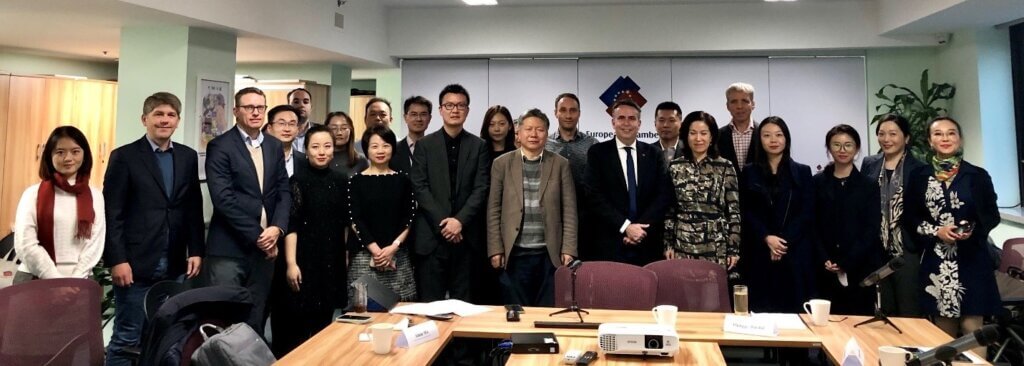
A total of about 50 policy makers, scholars and representatives from the aviation, maritime, automotive, freight transport and logistics industry participated in the workshop to discuss the implications of China’s transport sector goals and policies to the roadmap towards zero emissions.
Mr. Ma Aimin, Vice Director of National Center for Climate Change Strategy and International Cooperation (NCSC) of the Ministry of Ecology and Environment of the People’s Republic of China (MEE) has opened the workshop with an introduction of the recent climate strategy development in China, focusing on the 1+N policy system for carbon dioxide peaking and carbon neutrality. Mr. Ma highlighted that the transport sector is a key sector to achieve the 2030/2060 climate targets.
In her keynote speech, Ms Lisa Böltzig of the German Embassy in Beijing stated that climate-friendly technology is an important key to reduce the dependency on fossil fuels. She highlighted that both Europe and China face similar challenges when it comes to climate action in the transport sector and that with the European Green Deal and China’s 1+N policy system in place, it is now important to implement the measures needed to effectively lower emissions.
Mr Xu Honglei, Vice Director of the Transport Planning and Research Institute (TPRI) of the Ministry of Transport of the People’s Republic of China (MoT) and Mr. Philipp Klöckner of the German Environment Agency (UBA) elaborated on the set climate policies and targets in the European Union, Germany and China – Europe aims to become the first climate neutral continent by 2050 and China has set the target of becoming carbon neutral before 2060.
Mr Xu pointed out that China’s transport sector accounts for about 11% of the country’s total carbon dioxide emissions. Of these, road transport account for approximately 87% of total transport emissions. In particular in major cities, the share of transport emissions of the total emissions is relatively high (e. g. 37% in Shenzhen). Mr. Xu highlighted that the effective and immediate reduction of emissions from the transport sector is very important for achieving China’s 2030/2060 climate targets and improving the life quality of people. However, decarbonising China’s transport sector is a huge challenge as the demand for transport and transport equipment will continue to increase, and therefore also emissions are expected to further grow. There are technical bottlenecks in the reduction of carbon emissions per unit of transport, high costs of emission reduction and difficulties when it comes to the coordination between relevant departments. Mr. Xu stressed that the 2030/2060 climate targets are both a great challenge and an opportunity for the green transformation of the transport sector. The new climate targets will accelerate the necessary restructuring of the transport sector as part of a holistic transformation of China’s industrial and energy structure. Mr Xu recommended that the transport industry needs to choose a pragmatic and economic development path to reach the climate targets. Optimising the transport structure, improving energy and transport efficiency, promoting low-carbon transport equipment, promoting low-carbon infrastructure construction and operation, and guiding low-carbon travel will become the key elements on China’s low carbon transport pathway.
Mr Klöckner of the German Federal Environment Agency (UBA) presented the EU’s climate strategy – a complex set of policies including pricing measures, targets and rules. He stressed that the EU climate targets for 2030 (-55% compared to 1990) and 2050 (climate neutrality) are ambitious but achievable. Among the policies, the Emission Trading System (ETS) successfully led to a reduction of emissions in energy supply and heavy industry and that the new ETS II will contribute to reduce emissions from the road transport and buildings sectors. Electrification is the preferred way to decarbonise road transport. Therefore, the EU has to phase out internal combustion engines by 2035. Sustainable fuels (advanced biofuels and green power-to-x fuels) should be used in the aviation and maritime sectors. He also emphasised that climate-friendly transport requires an effective modal shift to low carbon transport modes, reducing travel and freight demand and improving transport efficiency.
In particular heavy-duty road freight, aviation, maritime transport and the coupling of the transport and energy sectors are considered as fields of high priority to decarbonise transport. Immediate measures are needed to steer the low carbon development in these fields, particularly against the background of long investment and research and development (R&D) cycles when it comes to e. g. propulsion technology adoption, and infrastructure construction. Therefore, experts from those fields have been engaged in dialogue in the workshop and shared their perspectives on solutions and the way ahead.
Ms Sun Xin from the China Automotive Technology and Research Centre (CATARC) highlighted the importance of the energy transition for the decarbonization of the automotive industry in China. Based on CATARC research, she recommended that full life-cycle carbon neutrality pathways for the automotive industry should cover the entire industrial chain including (1) clean power grid, (2) electrification of vehicles, (3) use of alternative fuels, (4) improvement of material efficiency, (5) improvement of vehicle production efficiency, (6) lower carbon emissions of power batteries incl. materials and manufacturing (7) improvement of energy efficiency in vehicle use, (8) shortening of travel distance.
Commercial vehicles account for a share of about 77% of road transport emissions in China and in particular the freight sector is a hard nut to crack when it comes to effectively lowering emissions (medium and heavy-duty trucks account for 360 million tons of CO2 emissions annually). Currently, there is no national heavy-duty new energy vehicle (NEV) goal and infrastructure program in place in China and the electrification rate is relatively low compared to e. g. urban buses. To provide insights from the industry, Mr. Joakim Diamant, Business Development Director of Scania China and Vice-Chair of the Automotive Working Group at the EUCCC shared perspectives from Scania. He stressed that all new trucks sold must be fossil free by 2040. Scania has set science-based targets and aims to reach 50% CO2 reduction from operations by 2025 (baseline 2015).
To decarbonise the logistics industry is a big challenge. Fuelled by digitalisation and e-commerce, express delivery volumes soared in China in recent years. While the total number of delivered parcels was 5.69 billion in 2012, this number increased to 63.52 billion by the end of 2019, an increase by a factor of 11. To share experiences from the industry, Ms. Ren Juanshu, Public Affairs Director of Alibaba’s logistics arm Cainiao, presented approaches to promote sustainable urban delivery by making use of digitalization and intelligent technology. Cainiao will improve the efficiency of information flow by digitalising paper documents. Further, the company will apply packing algorithms to decrease packaging and box waste, supply logistics facilities with renewable energy, promote green packaging and the efficient recycling of parcels.
The decarbonisation of the aviation sector is an important key to zero carbon transport but also is a hard nut to crack. Despite the impacts of COVID-19 to the aviation industry, the sector is expected to significantly grow in the coming years. During China’s 13th Five-Year Plan (2016-20) period, 43 civil airports were built or renovated (total of 241 civil airports in China) and during the 14th FYP period (2021-2025), 30+ new civil airports will be newly built.️ By 2025 China’s airports will have a total capacity of 2 billion passengers. The country’s aviation sector in 2018 accounted for about 13% of global commercial aviation CO2 emissions[1] (EU 18%, United States 24%) but per capita emissions are still low (China 0.09t CO2, United Kingdom 0.86t, United States 0.57t). It is expected that Chinese aviation sector CO2 emissions could quadruple by 2050 (ICCT). To provide industry insights, Mr Philippe Bardol, CEO of Safran China and Chair of Aviation and Aerospace Working Group at EUCCC, illustrated the role of the aviation sector for the roadmap towards zero emissions. An ambitious global commitment to halve CO2 emissions by 2050 (compared to 2005 levels) was announced as early as in 2008. According to Mr Bardol, making aviation carbon neutral requires all players to step up, including airlines and airport operators, aircraft and equipment manufacturers and regional and international regulatory authorities. For Safran, there are three top priorities: 1. developing ultra-efficient future aircrafts (40% lower fuel consumption), 2. using alternative fuels, and 3. inventing alternative propulsion technologies.
Accounting for about 80% of the world’s trade volume, the shipping industry is the backbone of the global economy. Shipping is responsible for about 3% of global greenhouse gas (GHG) emissions (85% from container ships, bulk carriers and oil tankers) and with growing trade volumes also emissions are on the rise. To lower emissions in the shipping industry, clear roadmaps have to be in place to guide the development of sustainable propulsion technology and the adoption of alternative fuels such as green hydrogen and ammonia or biofuels. Mr Tom Shi, General Manager of Regulatory Affairs at Maersk and Vice Chair of the International-liner shipping Sub Working Group at the EUCCC introduced the role of the maritime and inland waterways transport sector for the roadmap towards zero emissions. In 2018, Maersk committed to net-zero CO2 emissions by 2050. Four priority fuels, which are biodiesel, methanol, lignin fuels and ammonia are pursue for net emission shipping. Maersk will operate the world first carbon neutral liner vessel by 2023.
After all, the workshop participants made clear that it will require massive ambitions and investments and clear policies and technology pathways to reach the common goal of zero emission transport and eventually to align the sector with the goals of the Paris Agreement, the EU Green Deal and China’s 2030/2060 climate targets. The participants agreed that more and intensified dialogues among different stakeholders including policy makers, researchers and the industry are needed.
The workshop was organised as part of the National Determined Contribution Transport Initiative For Asia 2021 Event Series – Decarbonising Transport. The event series aims at contributing knowledge and international best practices on transport sector decarbonization to the development of strategies related to China’s 2030/2060 climate targets. Please find more information here: https://www.ndctransportinitiativeforasia.org/
If you want to know more about China’s transport and climate roadmap, please read our publication “Towards zero emissions: Overview on China’s climate pathway and implications to the transport sector”
[1] 69% from domestic operation
